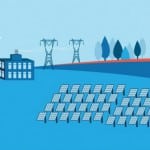The Trump administration’s Environmental Protection Agency (EPA) is considering its options to repeal or replace the Clean Power Plan (CPP), the signature climate regulation of former President Barack Obama.
POWER magazine on October 6 obtained a 43-page draft of the EPA’s proposed action on the CPP. The formal document is expected to be released soon. The document notes “The EPA has not determined whether it will promulgate a rule … to regulate greenhouse gas [GHG] emissions from existing EGUs [electric generating units], and, if it will do so, when it will do so and what form that rule will take.”
President Donald Trump has said the CPP violates federal law, something the EPA proposal says it will attempt to determine. Trump has said the emissions regulations could cost power consumers as much as $33 billion. He also has called the CPP a “job killer,” and in June said he would pull the U.S. out of the landmark Paris climate agreement after saying that man-made climate change is a “hoax.”
The CPP, which Obama instituted in 2015, aimed to reduce carbon dioxide (CO2) pollution levels by 32% below 2005 levels by 2030. It came after the U.S. rejected the 1997 Kyoto climate accord, and after Congress did not pass cap-and-trade legislation during Obama’s first term.
The Supreme Court froze implementation of the CPP in 2016. More than half the states, along with many industries reliant on burning fossil fuels, had sued over the rule. Then-Oklahoma Attorney General Scott Pruitt, now the EPA administrator under Trump, was among those who challenged the regulation.
The draft of the EPA proposal says the agency “is considering whether it is appropriate to propose such a rule and is intending to issue an Advance Notice of Proposed Rulemaking (ANPRM) in the near future. That ANPRM will solicit information on systems of emission reduction that are in accord with the legal interpretation proposed in this notice (i.e., those that are applicable at and to an individual source). The ANPRM will solicit information on compliance measures and state-planning requirements.”
Proposal Brings Quick Reaction
Reaction to the EPA’s draft proposal was swift from both supporters and opponents of the CPP. Tom Pyle, president of the Institute of Energy Research, a Washington, D.C.-based group that conducts research and analysis of global energy markets, on Friday told POWER in an emailed statement that “The so-called Clean Power Plan was an attempt by the Obama administration to nationalize the electricity grid, increase the cost of electricity, and bankrupt coal. A majority of states and the Supreme Court recognized this fact and today the Trump administration took an important step in limiting federal control over energy choices.”
Joseph Goffman, who served as Associate Assistant Administrator for Climate and Senior Counsel in the EPA and helped develop the CPP, and is now joining the environmental law program at Harvard Law School, said in an interview with POWER on Friday that “It seems to me that this is a thinly veiled but concerted strategy for Scott Pruitt and the Trump administration to avoid signing any rule that would require mandatory CO2 reduction from the power sector. They laid out in this 43-page document a process for repealing the existing plan, and they’ve laid out a separate, by design, protracted process for putting in place a different rule on CO2 emissions from the power sector. They’ve built into their process plenty of margin to push any sort of final rule past the current term of this administration.
“It’s quite brazen on a couple of levels. They’re simply inviting public comment on whether they should act at all, and the other brazen element is that they’re challenging the legal interpretation that went before the D.C. Circuit in 2016. It’s a game of delay. I’m sure their talking points will be focused on the cherry-picked points of their analysis.”
EPA Action Will Face Legal Challenges
Analysts who spoke on background to POWER on Friday said that whatever the EPA decides, any changes to the CPP will inevitably face legal challenges from states and environmental groups. It also could be challenged by groups in support of renewable energy, as they already have joined in opposition to the administration’s effort to give more support to coal and nuclear power in U.S. electricity markets.
In an e-mailed statement Friday obtained by POWER, former EPA Administrator Gina McCarthy said “A proposal to repeal the Clean Power Plan without any timeline or even a commitment to propose a rule to reduce carbon pollution, isn’t a step forward, it’s a wholesale retreat from EPA’s legal, scientific and moral obligation to address the threats of climate change.
“The Supreme Court has concluded multiple times that EPA is obligated by law to move forward with action to regulate greenhouse gases, but this administration has no intention of following the law. They are denying it just as they are denying the science. They’re using stall tactics to defer action, ignoring the courts and the demands of the American people.
“This administration is using contrived problems with our energy system to take money out of consumers’ pockets and giving it to fossil fuel companies, so they can force a shift away from clean energy and back to dirty fossil fuel. That’s not ‘back to basics,’ that’s just plain backwards.
“They’re adding more pollution into our air and threatening public health at a time when the threats of climate change are growing and the costs are growing immeasurably higher on our children and their future.”
The CPP established goals for each state that move the U.S. away from coal-fired power and toward natural gas and renewables such as wind and solar, along with supporting energy efficiency programs. At the time, the EPA under Obama said the plan had solid legal standing, though it relies on a seldom-used provision—section 111(d)—of the Clean Air Act.
The EPA draft obtained Friday says the CPP is illegal because it does not focus on what coal-fired plants could do on their own to cut carbon emissions. The proposal also discounts the economic and health benefits pushed by the Obama administration, which said slowing climate change and reducing air pollution would result in a healthier population; the former president said the social advantages outweighed the costs of the regulation.
However, some analysts who spoke with POWER noted that even as the U.S. Court of Appeals for the District of Columbia in August of this year said that litigation against the CPP would remain in abeyance another 60 days, judges Patricia Millett and David Tatel issued a concurring statement saying the EPA has an “affirmative statutory obligation to regulate greenhouse gases.” The judges also expressed concern that an indefinite delay in the litigation could impede the EPA from complying with that legal obligation.
—Darrell Proctor is a POWER associate editor (@DarrellProctor1, @POWERmagazine)










